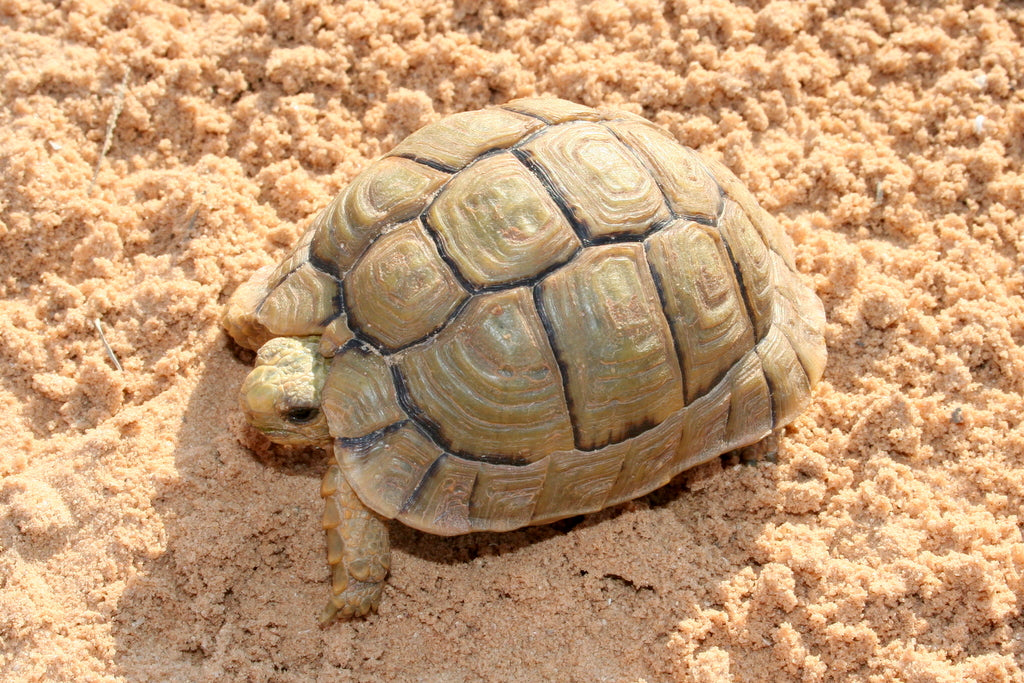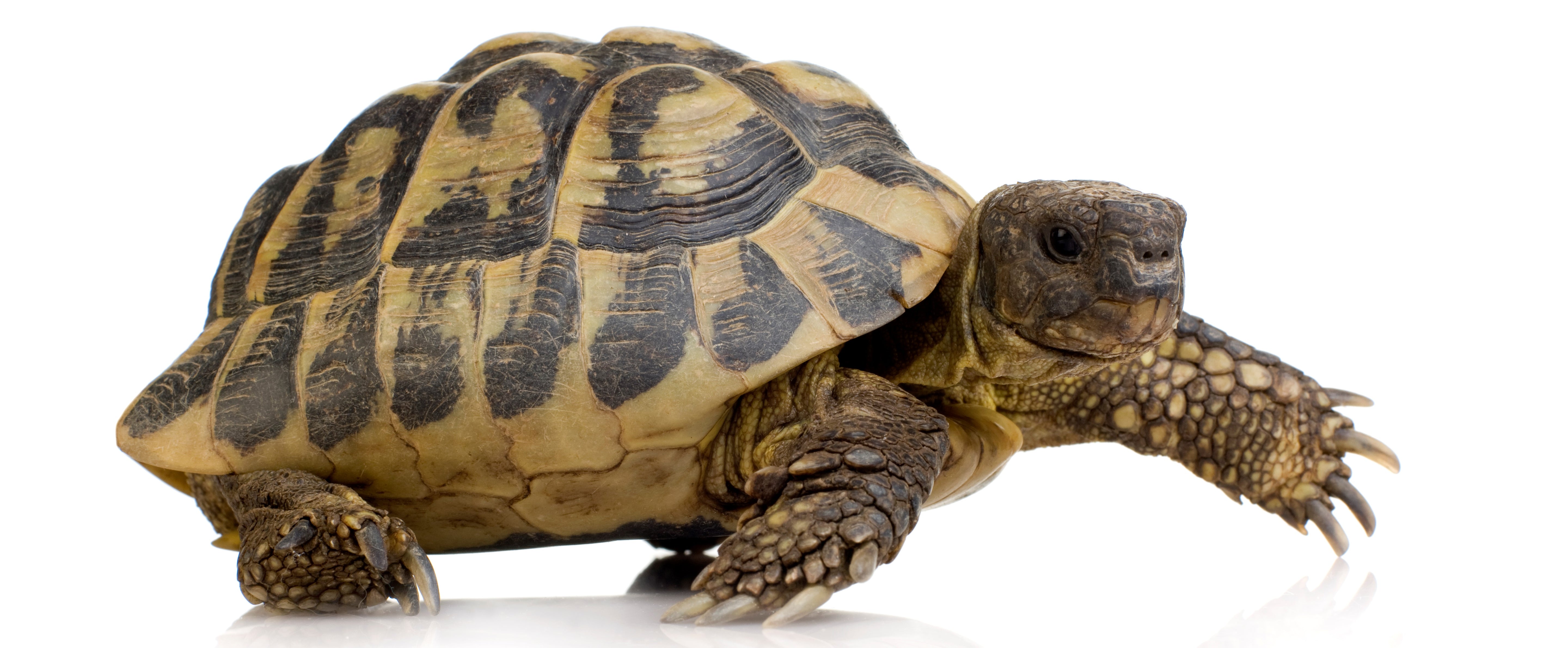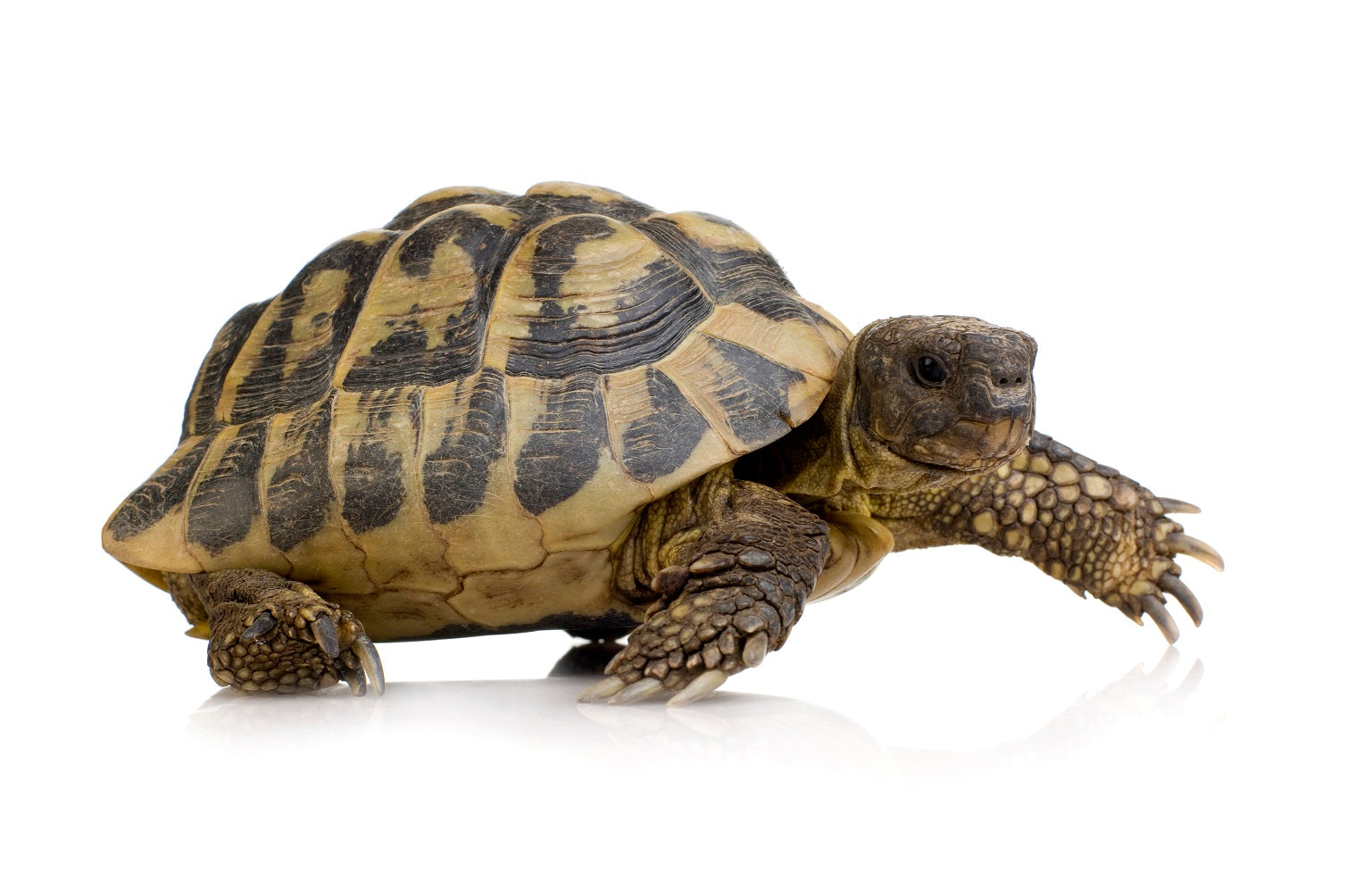Egyptian tortoises (Testudo kleinmanni) are a small species of tortoise native to coastal Libya, Egypt, and Israel. They prefer desert and semi-desert habitats with sandy substrate, sparse vegetation, and scattered rocks.
Egyptian tortoises are typically 4-5” long, although slightly smaller or larger is possible. They have a beige plastron with two large dark markings, a light to dark tan shell with dark scute borders, and the skin is generally similarly colored to the shell. There are no tubercles on their thighs.
Egyptian tortoises are an intermediate-level pet reptile, and can make great little pets once you’ve got their husbandry right. With good care, an Egyptian tortoise can live up to 26 years, although longer is possible.
How much space do Egyptian tortoises need?
A single Egyptian tortoise should have no less than 12 square feet of floor space. Like most tortoises, they are poor climbers and as such floor space is the most important consideration for an enclosure. If you can provide larger, do it!
Because of relatively low humidity requirements, it is possible to house this species in a “tortoise table” setup as long as they have access to areas of higher humidity, such as humid hides and burrows.
Egyptian tortoises are not particularly territorial, so although they can be housed alone, they can also be housed in groups. Note that you will need to provide more floor space for a group larger than two.
Do Egyptian tortoises need UVB?
Yes. Aside from helping provide a day/night cycle and an infinite supply of vitamin D, UVB is also essential to your tortoise’s overall health. The best UVB bulbs for Egyptian tortoises are:
- Arcadia T5 HO 12%
- Zoo Med T5 HO Reptisun 10.0
The bulb should be roughly half the length of the enclosure and mounted in a Arcadia or Vivarium Electronics fixture, placed on the same size as the heat lamp. The UVB lamp should be 17-18” above the top of the tortoise’s shell for best results.
Because Egyptian tortoises are desert animals, they do best when their enclosure is brightly illuminated. Add a strong 6500K LED or T5 HO fluorescent grow light to energize your tortoise and better simulate daylight.
All lighting should be on for 14 hours/day during summer and 10 hours/day during winter, with gradual adjustments in between.
What basking temperatures do Egyptian tortoises need?
Despite their desert origins, Egyptian tortoises don’t like to be hot. Shoot for a basking air temperature of 95°F, with a cool area on the other side of the enclosure between 70-80°F. Temperatures can get down to 60°F at night. Temperature should be measured with digital probe thermometers.
To create a basking area for your Egyptian tortoise, use a halogen flood heat lamps placed on one side of the enclosure, mounted at least 8” above your tortoise’s shell to provide even heating. Do not use ceramic heat emitters (CHEs), heat mats, red bulbs, or blue bulbs, as these are not as effective.
What humidity levels do Egyptian tortoises need?
As an arid species, Egyptian tortoises can survive fairly low humidity levels, but they also need access to areas of higher humidity to stay hydrated. Offer a humidity gradient of 20-40% on the warm end and up to 60% on the cool end. One of the best ways to do this is by offering a humid hide/burrow for the tortoise to use as needed. Your Egyptian tortoise’s enclosure should not be consistently wet, as this can cause skin, shell, and respiratory problems!
Humidity should be measured by a digital probe hygrometer with the probe in the middle of the terrarium.
What substrate is good for Egyptian tortoises?
Substrate covers the floor of your enclosure and helps make the setup more attractive, but it also helps maintain higher humidity levels and provides something for your tortoise to dig in as desired.
It’s ideal to use a substrate that imitates what Egyptian tortoises naturally live on in the wild. In other words, you’ll need something that resembles sandy soil. It should have small particles, not be too dusty, and pack well enough for burrowing.
We recommend the following substrates for Egyptian tortoises:
Plain topsoil mixed 60/40 with play sand also works well.
Substrate doesn’t need to be too deep — 2-3” is usually plenty. Replace this every 3-4 months. Remove poop and urates daily, along with contaminated substrate.
What décor can you use in a Egyptian tortoise terrarium?
It’s terribly boring for a reptile to be stuck in an enclosure with nothing in it except substrate, a hide, and food/water bowls. It doesn’t matter how big the enclosure is if you don’t put things in it for your pet to use and interact with.
Here are some décor ideas that are appropriate for Egyptian tortoises:
- additional hiding places/burrows
- large hollow logs
- live, edible plants
- large, flat stones
You can also shape the substrate into hills to provide an extra challenge.
What do Egyptian tortoises eat?
Egyptian tortoises are herbivorous, which means that they require a high-fiber diet. Food should be offered daily to growing juveniles, and every other day for adults.
Safe greens for Egyptian tortoises: cactus pads, kale, collard greens, turnip greens, mustard greens, dandelion greens + flowers, hibiscus leaves + flowers, nasturtium, alfalfa, clover, coreopsis, geranium, grape leaves, bluegrass, Bermuda grass, timothy grass, rye grass, fescue grass
Offering a commercial grassland tortoise diet once a week is a good way to help vary your tortoise’s diet and provide extra fiber. Mazuri’s grassland tortoise formula and Zoo Med Natural Grassland Tortoise Food are both good.
Never offer fruit or animal protein.
Supplements
You will also need calcium and vitamin supplements to prevent your tortoise from developing a potential deficiency. We recommend Repashy Superveggie, lightly dusted on each meal for vitamins and a cuttlebone for calcium.
Water
Of course, don’t forget a water bowl for your tortoise to drink from! This may be a desert species, but they still need regular access to water in order to stay hydrated. For best results, use a relatively large, shallow water dish like a terracotta saucer. Change the water daily and scrub the bowl with a reptile-safe disinfectant weekly, or whenever it becomes soiled.
Do Egyptian tortoises like to be handled?
Few reptiles actually “like” to be held, but Egyptian tortoises generally tolerate human interaction well, especially individuals that were bred in captivity. Never grab a tortoise from above, as that will scare it. Instead, approach from the side and scoop from below. Support as much of its body as possible. Start with very short handling sessions in the beginning, then gradually make them longer as your pet becomes more accustomed to you.
It’s best to keep the actual handling of your tortoise to a minimum. If you want to interact with your pet, try hand-feeding or lightly brushing its shell.
*This care sheet contains only very basic information. Although it’s a good introduction, please do further research with high-quality sources to obtain additional information on caring for this species.
"File:Testudo kleinmanni.jpg" by No machine-readable author provided. Abrahami assumed (based on copyright claims). is licensed under CC BY-SA 2.5




Leave a comment
This site is protected by hCaptcha and the hCaptcha Privacy Policy and Terms of Service apply.